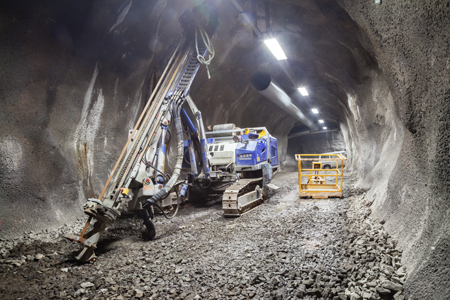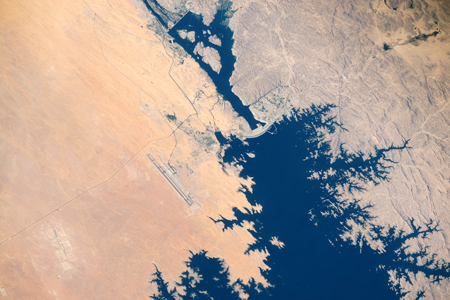In the largest compilation of anthropogenically induced earthquakes, causes range from building water reservoirs to mining.
Just in the United States, the number of earthquakes per year in the center of the country has jumped dramatically since the early 2000s. According to the U.S. Geological Survey (USGS), each year between 1973 and 2008, the central United States experienced about 21 earthquakes of magnitude 3 or higher. This number grew to almost 100 per year between 2009 and 2013. In 2014 alone, the region experienced more than 400 earthquakes.
In the past few years, scientists have begun to better understand the relationship between industrial processes and “induced” earthquakes. Recent media attention has zeroed in on fracking and wastewater injection, but earthquakes are also induced by the load of water impounded behind a dam, mining processes, and extracting groundwater for irrigation, among other causes.
After repeated small quakes struck areas around an oil field in the Netherlands, the Dutch oil and gas exploration company NAM commissioned a study by earthquake experts to better understand human-induced earthquakes. The team, led by Gillian Foulger, a geologist at Durham University in the United Kingdom, ended up compiling the most complete database of occurrences to date. The team also found that induced earthquakes are “tremendously underreported,” Foulger said. She presented her team’s findings on Tuesday, 13 December.
Hunting for Quakes
Foulger and her colleagues spent a year digging through scientific literature, industry literature, newspaper reports, and accounts from colleagues to create the database of as many previously reported induced earthquakes as they could find. The database, which stretches back through the early 19th century, currently lists 715 earthquake sequences, each consisting of as many as several hundred quakes.The catalog divides the causes of induced earthquakes into four general triggers: surface operations (such as quarrying, building structures, and impounding water reservoirs), injecting material into the subsurface (such as wastewater disposal in fracking), removing material from the subsurface (such as mining or pumping water for irrigation), and explosions from underground nuclear tests.
Mining-Induced Quakes Dominate

Mining falls under the category “removing material from the subsurface.” Imagine gradually removing support beams and walls from a tall building, Foulger said—at some point, the building will collapse.
In 2007, for example, more than 100 mines in China reported seismic events larger than magnitude 4, Foulger said. In 1989, an induced magnitude 5 quake in Germany collapsed the surface over 5 square kilometers of a potash mine, killing three.
Not all the mining-induced quakes are so large, however. The majority of the mining quakes in the database range between magnitudes 2 and 4, according to the report.
Earthquake Sources in Groundwater Removal
Another example from the “removing material” column stems from Spain, Foulger said. In 2011, a magnitude 5.1 earthquake razed a small town called Lorca and killed 10 people. Research following the earthquake tied the event to the decades-long removal of water from the ground for irrigation, which drastically lowered the water table. This led to ground subsidence and resulted in the earthquake.In fact, a 2014 paper in Nature found that the increase in small earthquakes recorded in California’s San Joaquin Valley could be tied to underground water removal. More than 100 cubic kilometers of water have been removed from the ground in the region over the last 150 years, mostly for irrigation purposes. “The removal of any mass from under the ground is going to create voids, and essentially the earth is going to collapse,” Foulger said. “There’s just so much material you can remove from the earth before it has to subside.” And sometimes that subsidence results in an earthquake, she continued.
Dam-Induced Quakes

A notable example is the Koyna Dam in India, which impounds about 3 cubic kilometers of water. There, a magnitude 5 earthquake occurs about every 5 years, according to the researchers’ report.
Other examples in the report include Egypt’s Aswan High Dam, which impounds about 132 cubic kilometers of water and has induced earthquakes up to magnitude 5.7. Also, in 2007, more than 7000 earthquakes were recorded over a 2-month period in Algeria as water was pumped from one reservoir into another.
Database for All
Unfortunately, induced earthquakes are likely underreported, Foulger noted, because documented earthquake sequences tend to come from places where humans felt them. Some projects, such as offshore oil and gas extraction, may be far from people, where earthquakes aren’t felt and thus aren’t recorded, she explained.A corollary of this is that as populations move and grow, risk increases. For example, 15 years ago, “the residents of Oklahoma would not have suffered from the quakes” because, at that time, fewer people lived near areas where ongoing industrial processes induced quakes, Foulger explained. In the spring, Foulger and her colleagues will launch a website, InducedEarthquakes.org, which will allow anyone to report induced earthquakes. She hopes that by crowdsourcing for more information, researchers will be able to use the database to further catalog induced earthquakes and thus better understand them.
One caveat, Foulger also noted, is that the current list includes not only confirmed induced quakes but also earthquakes that scientists don’t necessarily agree were induced.
This could potentially cause problems, noted Susan Hough, a seismologist at the USGS’s Earthquake Science Center in Pasadena, Calif., who wasn’t involved with the research. “There will be a danger of people taking the catalog as gospel, not appreciating the fact that some associations remain controversial,” she said.
However, it’s a “worthy effort to try to compile a catalog,” Hough continued. “It will be useful to test hypotheses about induced earthquakes and, fundamentally, to highlight the scale and scope of the problem.”
Minimizing Risk
Despite the fears surrounding induced earthquakes, however, Foulger stressed that concerned parties should work with industry leaders to manage risk rather than attempt to cease industrial activities altogether. Think of it like building a road, she explained. The future road may be a source of car accidents, but “people don’t prevent industrial activity because new roads have to be built. These earthquakes are the same—a potentially dangerous side effect of industrial activity that needs to be managed.”—JoAnna Wendel (@JoAnnaScience), Staff Writer
Citation: Wendel, J. (2016), It’s not just fracking: New database of human-induced quakes, Eos, 97, doi:10.1029/2016EO065433. Published on 22 December 2016.
https://eos.org/articles/its-not-just-fracking-new-database-of-human-induced-quakes

No comments :
Post a Comment